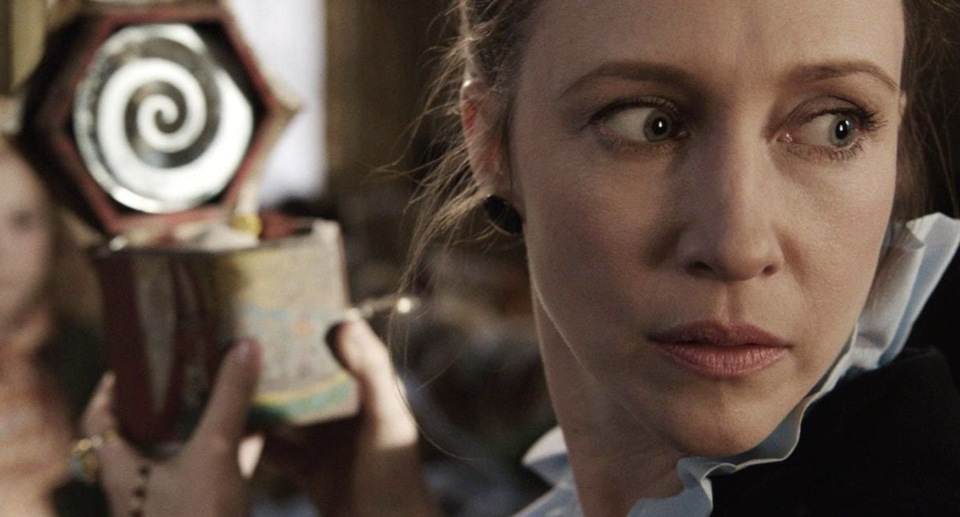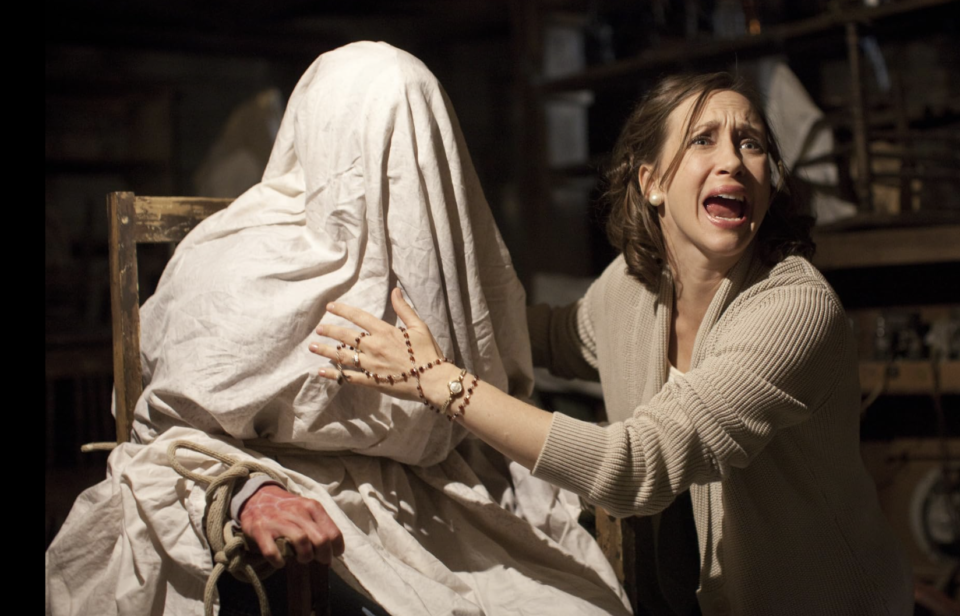Look What Bathsheba Made Us Do: ‘The Conjuring’ And Manifesting An Evil Witch

With cinematic universes all the rage, the past decade of horror has been dominated by a phenomenon cheekily called the Wanoverse. Nearly ten years after helping to kickstart the torture porn subgenre, James Wan ignited a new web of genre films by tackling a real-life pair of paranormal investigators. Ed (Patrick Wilson) and Lorraine Warren (Vera Farmiga) were preeminent demonologists, consulting on cases across the English-speaking world. With a lengthy catalog of case files, The Conjuring reimagines the true story of the Perron family haunting, proclaimed to be the duo’s most horrific assignment. Though many details have been embellished to create a more dramatic narrative, the Perrons did experience ghostly phenomena during the ten years they lived in their Rhode Island farmhouse.
The purpose of this essay is not to reify or debunk their claims of haunting, nor is it to investigate the real-life actions of the Warrens themselves. We are here today to discuss the female killer at the center of this film, a hellish woman named Bathsheba.
Her Story

The Conjuring begins with another femme fatale, the infamous Annabelle. Rest assured, gentle reader, we will tackle this diminutive killer soon. After a short vignette that introduces us to the Warrens through their infamous collection of haunted artifacts, we meet the famous couple as they deliver a guest lecture on demonic possession and exorcism. We also meet the Perron family, Roger (Ron Livingston), Carolyn (Lili Taylor), and their five daughters, who’ve just bought a rambling house at auction. They barely moved in before finding a boarded-up stairwell leading down to a dusty basement.
Soon after this discovery, members of the family begin to notice strange occurrences at night. Ghostly hands steal the covers and a sinister figure lurks in the dark corners of the daughters’ bedrooms. Youngest child April (Kyla Deaver) begins talking to an imaginary friend who appears at the behest of an antique music box and Carolyn notices an increasing amount of bruises forming on her body in the night. It’s not until the 43-minute mark that we meet the sinister Bathsheba (Joseph Bishara), the cause of these nightmarish events. Late one night, two of the sisters notice a hideous crone with glowing eyes and a snarling mouth crouched on top of an antique armoire that came with the house.
Once the Warrens are brought on the case, they investigate the history of the house. It seems a woman named Bathsheba Sherman owned the land with her husband in the mid-19th century. After sacrificing her week-old baby to Satan, she cursed the land and then hanged herself from a tree on the property. In the years between the Shermans and the Perrons, the house has been the site of several gruesome murders and suicides all involving mothers and their children. Several of these victims appear in the house with the poor ghostly women usually exclaiming some variation of “Look what she made me do!”
Her Motive

Writers Chad and Carey W. Hayes give us next to nothing regarding Bathsheba’s motive. The Warrens call her a witch and we learn that she was related to Mary Towne Easty, a real victim of the Salem Witch Trials. However, to the best of our knowledge, we know that the people executed in 17th-century Salem were innocent Christians caught up in a deadly paranoia sweeping the settlement. This connection to a real woman wrongly convicted and executed for a made-up crime seems to simply be a shorthand: woman/witch = evil. With the majority of Wan’s film concerned with building ambiance in the haunted house, an aesthetic that would soon come to define his films, there’s not much room to develop this female killer.
For more information about the witch’s crimes, we can turn to the biblical origin of this unusual name. Bathsheba was the Queen Mother of Israel in the 10th Century BC. Wife of King David and mother of King Solomon, her journey to the throne is filled with bloodshed and adultery. Bathsheba was married to a man known as Uriah the Hittite when King David surveyed the city from a rooftop.
Spying Bathsheba bathing in a courtyard, he sent messengers to bring the beautiful woman to him while her husband was away and she quickly became pregnant. Hoping to hide the results of this adultery, David sent Uriah to the front lines of battle where he was killed, allowing David to marry the mother of his illegitimate child. David eventually repented of his sins and received forgiveness. However, Bathsheba was not so lucky. The baby conceived out of wedlock died as punishment for the transgression, another tragedy stemming from David’s lust. Bathsheba would later bear David a son named Solomon, the legendary King of Israel.
Bathsheba’s story has become somewhat controversial in religious circles with much of the discourse centered on her “affair” with David. Though the man responsible for killing Goliath was already married to several women, much is made of Bathsheba’s marital status while she bathed naked in a private courtyard. Some believe that David essentially raped his future wife while others assert that her public nudity sparked an uncontrollable lust in the well-meaning man.
We don’t know how Bathsheba felt about David’s attraction to her, but she would have been essentially powerless to reject the advances of her king. Bathsheba’s first child with David essentially became a sacrifice to pay for the sin of adultery, an uncomfortable comparison to the witch’s backstory in The Conjuring. The Queen Mother of Israel is a complicated historical figure, but has also been described as a dangerous temptress, taunting David with her beauty and essentially causing his sin. What we would now call slut-shaming, this depiction also bears an uncomfortable connection to the phrase, “Look what she made me do.”
Her Weapons

When haunting the Perron family, Bathsheba uses a variety of unseen weapons. Hoping to cause maximum terror, she murders the family dog, destroys treasured photos, and stops clocks at the unholy moment of her long-ago death. We occasionally see a pair of ghostly hands mimicking a family game called Hide and Clap, but she accomplishes most of her torment cloaked in invisibility. Unseen to most of the Perrons, she opens doors, steals covers, and drags the girls around by their hair hoping to break the family down before killing them all.
Following the three stages of demonic possession, Bathsheba eventually takes over the body of Carolyn Perron. In a chilling scene, she appears directly over the mother of five and spews a foul liquid into her mouth. From that moment, Carolyn’s body operates at Bathsheba’s behest. After fleeing the house with her family, she drives two of her daughters back to the house and attempts to murder them both with scissors. Previously used to cut the hair gripped in Bathsheba’s translucent hands, these domestic tools are likely the first weapons she happens to find.
Under the witch’s control, Carolyn screams and contorts her body, desperately trying to break free so that she can sacrifice her daughters. In the throes of an exorcism, Bathsheba knocks over bookshelves, fires guns, and smashes furniture in an all-out attempt to escape the exorcism and murder the children. As Lorraine says, “She uses the mother to murder the child.” making her primary weapon the mothers themselves.
Her Victims

After torturing poor Carolyn, Bathsheba wastes little time enacting her deadly plans for her daughters. Like her vague motive, Bathsheba seems to simply want to kill as many of the Perron offspring as possible. Though she has no control over who moves into the house, it’s not a coincidence that she haunts a house full of young women. Bathsheba is the epitome of a Bad Mother, one who would kill her child simply to prove her evilness. This puts her in sharp contrast to Carolyn and Lorraine. Working as an agent of the church, Lorraine is a Good Mother, caring for her young daughter and devoted to her husband. While the real Warrens were anything but saintly, Wan’s version of the couple is pious but kind. They continually espouse their religious convictions and investigate through a God-centered lens.
Carolyn Perron is not a religious woman, but she is a traditional housewife. She stays at home to care for her five daughters while Roger drives his long-haul trucking routes. While there is nothing inherently wrong with what either woman does in the film, they provide alternatives to the flatly evil Bathsheba. When Carolyn asks what kind of mother would kill her child, Lorraine answers, “It was never a child to her. She just used her god-given gift as the ultimate offense against him.”
During the climactic exorcism, Lorraine tells Roger that they are fighting for Carolyn’s soul. While this may be true, by rejecting Bathsheba, they are also fighting to exemplify what a good mother should be for the five daughters who live in the home. Early in the Perrons’ story, a Moving Day montage set to “Time of the Season” by the Zombies firmly situates the film in the late 60s and early 70s, a decade that saw many women burn their bras, reject patriarchal oppression, and turn to Second Wave Feminism. When viewing all of the film’s puzzle pieces as a whole, The Conjuring feels like a warning: feminist behavior that begins with bathing in a courtyard could eventually lead to sacrificing your baby to Satan.
Her Legacy

While there are many women in the world like Lorraine, there are thankfully few like the cinematic Bathsheba. However, these two mothers create a spectrum of caregiving with two extreme polarities. In addition to fighting for Carolyn’s soul, the Warrens are also fighting for her place on this continuum. Will she be like Bathsheba? Or will the church win, expel the dangerous influence, and prove the superiority of God-fearing women like Lorraine? Perhaps when the Perron family’s nightmarish ordeal is over, they’ll even take Ed’s suggestion and reconsider going to church. Further films in the franchise would double down on the Warrens as Christian warriors, but the seeds of religion begin to flourish in the franchise’s first film.
Like her biblical counterpart, Bathsheba Sherman was a real woman. Born in 1812, she and her husband Judson were wealthy landowners who lived on the property the Perrons would purchase. Not much information about her life remains, however, we know that she did have a son named Herbert and possibly three additional children who died before reaching the age of seven. The origin of Bathsheba’s cinematic backstory appears to be a tragic incident in which an infant died in Bathsheba’s care. The relatively wealthy landowner, rumored to be cruel to her household staff, was accused of satanism and tried for the child’s murder. She was reportedly acquitted, though public perception had already turned against her. Bathsheba Sherman died an old woman, outliving her husband by four years.
The Conjuring is a supremely terrifying film and Wan’s sinister aesthetics would ignite a new wave of bloodless, yet frightening, horror films. Ten years later, it still packs a mean punch with its harrowing nighttime sequences and fantastic use of darkness and light. There’s a reason it’s gone on to generate two direct sequels and an ever-expanding franchise of connected stories. The film’s success lies in its ability to consistently scare audiences without ever making use of cheap gimmicks, but the characterization of its central villain is rather clumsy.
Not only does Wan build on the stories of four real women, but he drastically oversimplifies the lives and motivations of everyone involved. Like the casually referenced Mary Towne Eastey, Bathsheba was a real person with a complicated life named after another woman whose life was turned upside down by a man’s lust. Regardless of the true facts of their lives, the success of The Conjuring ensures that the name Bathsheba will forever be associated with the phrase, “Look what she made me do.”
Categorized:Editorials

